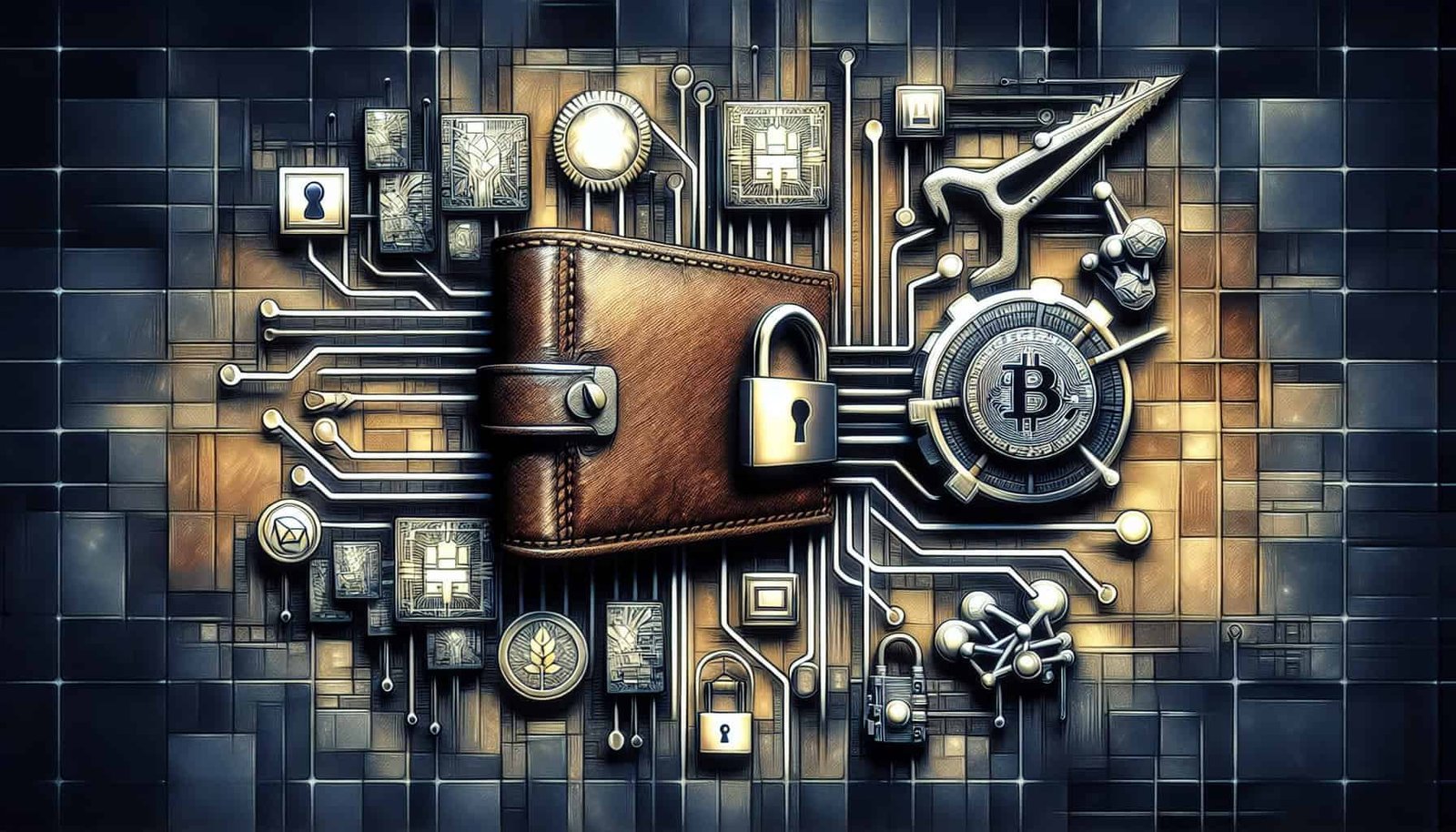Have you ever wondered about the challenges of cryptocurrency storage and custody? In an increasingly digital world, where cryptocurrencies such as Bitcoin and Ethereum have gained immense popularity, it is essential to understand the risks and obstacles associated with storing and safeguarding these valuable digital assets. From the threat of hacking and cyberattacks to the complexities of securing private keys, this article explores the various challenges that individuals and institutions face when it comes to the storage and custody of cryptocurrencies. So, read on to discover the intricate world of cryptocurrency storage and the measures taken to protect these digital treasures.

Security Challenges
The Risk of Hacking
One of the primary challenges of cryptocurrency storage and custody is the risk of hacking. As cryptocurrencies have gained popularity and value, they have become an attractive target for hackers. Traditional centralized exchanges and online wallets have suffered multiple security breaches over the years, resulting in the theft of millions of dollars worth of cryptocurrency.
The decentralized nature of cryptocurrencies, which eliminates the need for intermediaries like banks, also means that users are solely responsible for the security of their digital assets. Any weakness or vulnerability in the user’s devices, software, or online platforms can be exploited by hackers to gain unauthorized access to their private keys and steal their cryptocurrency.
To mitigate the risk of hacking, it is essential to follow security best practices, such as using hardware wallets, employing multi-factor authentication, and regularly updating software and devices.
Vulnerability to Cyber Attacks
In addition to hacking, the vulnerability to cyber attacks is another security challenge in cryptocurrency storage and custody. Cyber attacks encompass a wide range of malicious activities, including distributed denial-of-service (DDoS) attacks, malware, phishing, and ransomware attacks.
Cryptocurrency exchanges and custodial platforms are often targeted by DDoS attacks, which overwhelm their servers and disrupt their services. Malware and phishing attacks, on the other hand, aim to trick users into revealing their private keys or login credentials, allowing the attackers to gain unauthorized access to their cryptocurrency.
To protect against cyber attacks, users and service providers need to stay vigilant and implement robust security measures, such as employing advanced encryption techniques, regularly patching software vulnerabilities, and conducting security audits.
Lack of Regulation and Protection
Another significant security challenge in cryptocurrency storage and custody is the lack of comprehensive regulation and protection. Unlike traditional financial systems, where governments and regulatory bodies play a crucial role in ensuring security and protecting consumers, the cryptocurrency market operates in a relatively unregulated environment.
This lack of regulation leaves users vulnerable to fraudulent schemes, unreliable service providers, and unsecure practices. There have been instances of cryptocurrency exchanges abruptly shutting down or engaging in fraudulent activities, resulting in the loss of users’ funds.
To address this challenge, regulators need to develop clear and enforceable frameworks that protect consumers and establish standards for security and custodial practices. Additionally, users need to exercise caution and conduct thorough research before trusting their cryptocurrency with any third-party service provider.
Insider Threats
Insider threats pose yet another security challenge in cryptocurrency storage and custody. These threats refer to the risks posed by individuals within organizations who have authorized access to sensitive information or systems. In the context of cryptocurrencies, insiders could be employees of cryptocurrency exchanges or custodial platforms who have access to users’ funds.
Insiders with malicious intent can exploit their privileged access to steal users’ cryptocurrency or compromise the security of the entire platform. Insider threats can be particularly challenging to detect and prevent since insiders often have legitimate access to the systems they are attacking.
To mitigate the risk of insider threats, service providers need to implement strict access controls, conduct background checks on employees, and regularly monitor and audit their systems for any suspicious activity. Users should also consider diversifying their cryptocurrency holdings across multiple platforms to minimize the impact of any potential insider threats.
Technical Challenges
Wallet Vulnerabilities
Storage and custody of cryptocurrencies primarily rely on digital wallets, which are essentially software applications used to store and manage private keys. However, these wallets are not immune to vulnerabilities, posing a significant technical challenge.
Various types of wallet vulnerabilities can be exploited by hackers to gain unauthorized access to users’ private keys and steal their cryptocurrency. These vulnerabilities include software bugs, insecure random number generation, weak encryption techniques, and poor user interface design.
To minimize wallet vulnerabilities, it is crucial to choose wallets from reputable sources and regularly update them with the latest security patches. Additionally, users should consider using hardware wallets, which store private keys offline and offer enhanced security features.
Irreversible Transactions
Cryptocurrency transactions are typically irreversible, meaning that once a transaction is confirmed on the blockchain, it cannot be reversed or altered. While this feature provides immutability and security, it also poses a challenge in cases of accidental transactions or fraudulent activity.
If a user mistakenly sends cryptocurrency to the wrong address or falls victim to a scam, recovering the funds can be extremely difficult, if not impossible. Unlike traditional financial systems, where banks can reverse fraudulent transactions or provide assistance in resolving disputes, the decentralized nature of cryptocurrencies makes it nearly impossible to reverse transactions once they are confirmed.
To mitigate the risk of irreversible transactions, users need to exercise caution when entering wallet addresses and conducting transactions. Additionally, education and awareness about common scams and fraudulent activities can help users identify and avoid potential risks.
Complexity of Private Key Management
The management of private keys, which are essential for accessing and transferring cryptocurrencies, can be complex and challenging for many users. Private keys are essentially long strings of alphanumeric characters that act as digital signatures to validate transactions.
However, private keys must be securely stored to prevent unauthorized access, which can be a daunting task for users who are not familiar with cryptographic concepts. Losing or mishandling private keys can result in the permanent loss of cryptocurrency.
To address the complexity of private key management, the development of user-friendly interfaces and secure storage solutions is crucial. Hardware wallets, for example, offer simplified processes for generating and storing private keys, making them more accessible to a wider range of users.
Lost or Forgotten Passwords
Lost or forgotten passwords present a common yet significant technical challenge in cryptocurrency storage and custody. Since most cryptocurrency wallets are protected by passwords or passphrases, users who forget or misplace their login credentials can become permanently locked out of their wallets.
Unlike traditional financial systems, where password recovery mechanisms exist, the decentralized nature of cryptocurrencies means that there is no central authority to facilitate password recovery.
To mitigate the risk of lost or forgotten passwords, users should consider employing robust password management strategies, such as using password managers, enabling multi-factor authentication, and creating secure backups of their wallet credentials. Regularly updating and securely storing password information is also crucial to prevent loss of access to cryptocurrency holdings.
Operational Challenges
Accessibility and Usability
One of the operational challenges in cryptocurrency storage and custody is ensuring accessibility and usability for all users. While cryptocurrencies strive to provide financial inclusion to individuals without access to traditional banking services, the technical complexities associated with cryptocurrency storage can create barriers for many users.
Cryptocurrency wallets and custodial platforms often require a certain level of technical knowledge and familiarity with digital tools, which can be intimidating for newcomers. Additionally, the decentralized nature of cryptocurrencies means that users are solely responsible for the security and management of their assets, further increasing the operational burden.
To enhance accessibility and usability, service providers need to develop user-friendly interfaces and educational resources that simplify the process of storing and managing cryptocurrencies. Simplified onboarding processes and intuitive interfaces can encourage wider adoption and empower users with diverse levels of technical expertise.
Lack of User-Friendly Interfaces
Related to the challenge of accessibility and usability is the lack of user-friendly interfaces in many cryptocurrency storage and custody solutions. While the underlying technology behind cryptocurrencies is complex, the user experience should be as seamless and intuitive as possible.
Unfortunately, many wallet applications and custodial platforms still suffer from clunky interfaces, confusing terminology, and poor user experience design. This can deter newcomers from adopting cryptocurrencies and result in errors or security vulnerabilities due to user misunderstandings.
To address this challenge, service providers should prioritize user-centric design principles when developing wallets and custodial platforms. Conducting user testing and incorporating user feedback into the design process can help identify pain points and improve the overall user experience.
Integration with Traditional Financial Systems
Integrating cryptocurrencies with traditional financial systems presents another operational challenge in storage and custody. While cryptocurrencies aim to provide an alternative financial system, their compatibility with existing systems and regulations is limited.
The lack of seamless integration between cryptocurrencies and traditional financial institutions can create hurdles for users looking to transfer funds between the two systems or convert between fiat and cryptocurrencies. Users may need to rely on centralized exchanges or third-party services, increasing the operational risks and potential for fraud or theft.
To overcome this challenge, regulatory frameworks and collaboration between cryptocurrency service providers and traditional financial institutions are essential. Establishing clear guidelines and streamlining processes for exchanging cryptocurrencies with fiat currencies can enhance accessibility and bridge the gap between the two financial systems.
Scalability and Speed
Scalability and speed are significant operational challenges in cryptocurrency storage and custody. As the adoption of cryptocurrencies continues to grow, the underlying blockchain networks face increasing demands in terms of transaction volume and processing speed.
Bitcoin, for example, has faced scalability challenges, leading to congestion on its blockchain and increased transaction fees during peak periods. Slow transaction confirmation times can hinder the usability and practicality of cryptocurrencies for everyday transactions.
To address scalability and speed challenges, ongoing research and development efforts are being undertaken to optimize blockchain networks and implement scaling solutions. These efforts include layer-two solutions, such as the Lightning Network, and the development of alternative consensus algorithms to improve transaction throughput.
Regulatory Challenges
Unclear Legal Frameworks
One of the key challenges in cryptocurrency storage and custody is the lack of clear and cohesive legal frameworks. Cryptocurrencies operate in a borderless, decentralized environment, making it challenging for regulators to establish consistent rules and regulations.
The absence of clear legal frameworks can lead to regulatory uncertainty, creating barriers to entry for businesses and deterring institutional investors. It can also contribute to market volatility and expose users to potential risks associated with unregulated practices.
To address this challenge, regulatory bodies need to work collaboratively at both the national and international levels to develop comprehensive, technology-neutral regulations. These regulations should focus on protecting consumers, preventing money laundering and illicit activities, and fostering innovation and growth in the cryptocurrency ecosystem.
Compliance and Anti-Money Laundering (AML) Regulations
Compliance with anti-money laundering (AML) regulations is another significant regulatory challenge in cryptocurrency storage and custody. Cryptocurrency transactions, by their nature, are pseudonymous, enabling individuals to conduct transactions without necessarily revealing their real-world identities.
This pseudonymity feature has raised concerns among regulators and governments regarding the potential for cryptocurrency to be used for money laundering, terrorist financing, and other illicit activities. As a result, many jurisdictions have implemented AML regulations that impose certain reporting and compliance requirements on cryptocurrency service providers.
Ensuring compliance with AML regulations can be challenging for cryptocurrency storage and custody providers, as it requires implementing robust identity verification processes and transaction monitoring practices. Failure to comply with these regulations can result in legal consequences, including fines, license revocation, or even criminal charges.
Cross-Border Regulatory Differences
The cross-border nature of cryptocurrencies poses another regulatory challenge for storage and custody. As cryptocurrencies can be transferred globally without the need for intermediaries, regulatory differences between jurisdictions can create complexities and potential legal risks.
Cryptocurrency service providers need to navigate a patchwork of regulations and comply with varying requirements when operating in multiple jurisdictions. This can involve additional administrative burdens, legal costs, and risks of non-compliance.
To address the challenge of cross-border regulatory differences, international cooperation and standard-setting bodies play a crucial role. Harmonizing regulations across jurisdictions and establishing clear guidelines for cross-border cryptocurrency transactions can facilitate regulatory compliance and foster global interoperability.
Licensing Requirements
Obtaining the necessary licenses to operate as a cryptocurrency storage and custody provider can be a complex and time-consuming process. Different jurisdictions have different requirements and criteria for granting licenses, often resulting in regulatory burdens for businesses operating in multiple regions.
The lack of standardized licensing procedures and the varying nature of licensing requirements can create uncertainty and barriers for businesses looking to enter the cryptocurrency storage and custody market.
To navigate this challenge, service providers need to conduct thorough research on the licensing requirements in the jurisdictions they wish to operate in. Engaging with legal and regulatory experts can help navigate the complexities and ensure compliance with licensing obligations.

Custodial Challenges
Trust and Accountability
Cryptocurrency storage and custody involve entrusting digital assets to third-party service providers. Establishing trust and ensuring accountability between users and custodial platforms pose significant challenges.
Users need to have confidence that their assets will be securely stored and that custodial platforms will act in their best interest. However, numerous cases of fraudulent activities, unexpected closures, and mismanagement have eroded trust in custodial solutions.
To address the challenges of trust and accountability, custodial platforms should prioritize transparency and establish mechanisms for independent audits and regular reporting. Clear communication channels and responsive customer support mechanisms can also help foster trust and provide users with reassurance.
Third-Party Risks
The involvement of third-party service providers in cryptocurrency storage and custody introduces inherent risks. Users who opt to leverage custodial platforms to manage their digital assets are essentially trusting these intermediaries with their funds.
However, the history of cryptocurrency has shown that custodial platforms can be vulnerable to hacking, insider attacks, and other security breaches. If a custodial platform is compromised, users may lose their funds, and in some cases, recovery can be challenging or impossible.
To mitigate third-party risks, users should conduct thorough due diligence before selecting a custodial platform. Evaluating the platform’s security measures, reputation, and track record can help users assess the level of risk associated with entrusting their assets to a third party.
Escrow and Multisig Solutions
Escrow and multisignature (multisig) solutions are emerging mechanisms to enhance the security and trustworthiness of cryptocurrency storage and custody. Escrow solutions involve a trusted third party holding funds in a transaction until predetermined conditions are met.
Multisig solutions, on the other hand, require multiple parties to authenticate and authorize transactions, providing an additional layer of security. For example, a wallet may require two out of three authorized parties to sign off on a transaction.
Implementing escrow and multisig solutions address the challenges of trust and accountability by reducing the reliance on a single entity or individual. These solutions can provide users with added confidence in the security of their funds and reduce the risk of unauthorized transactions.
Balance Between Security and Accessibility
Achieving the right balance between security and accessibility is a fundamental challenge in cryptocurrency storage and custody. On one hand, robust security measures are essential to protect digital assets from theft and unauthorized access. On the other hand, overly complex security processes can hinder accessibility and usability.
Striking the right balance requires considering different user profiles and their specific security needs. Retail users, for instance, may prioritize ease of use and accessibility, while institutional investors may have stricter security requirements.
Service providers need to offer flexible solutions that cater to varying security preferences, while ensuring that the overall security of the platform is not compromised. Providing users with customization options, such as enabling different levels of security features, can help strike the balance between security and accessibility.
The Human Factor
Lack of Awareness and Education
The human factor poses significant challenges in cryptocurrency storage and custody. Lack of awareness and education about cryptocurrencies, their underlying technology, and security best practices can expose users to unnecessary risks.
Users who are not familiar with the technical intricacies of cryptocurrencies may fall victim to scams, phishing attacks, or simply make mistakes that result in the loss of their funds. Additionally, users may not understand the importance of securely storing and managing their private keys, further increasing the risk of theft or loss.
To address the challenge of lack of awareness and education, industry stakeholders need to invest in educational initiatives and raise awareness about the risks and best practices associated with cryptocurrency storage and custody. Providing accessible resources, conducting training sessions, and collaborating with educational institutions can help bridge the knowledge gap and empower users to protect their digital assets.
Phishing and Social Engineering Attacks
Phishing and social engineering attacks are prevalent challenges in cryptocurrency storage and custody. These attacks involve tricking users into revealing their private keys or login credentials, allowing attackers to gain unauthorized access to their cryptocurrency.
Phishing attacks typically involve sending fraudulent emails or creating fake websites that mimic legitimate cryptocurrency service providers. Social engineering attacks, on the other hand, exploit human psychology to manipulate users into revealing sensitive information.
Users need to be vigilant and exercise caution when interacting with emails, links, or requests for sensitive information related to their cryptocurrency holdings. It is essential to verify the authenticity of communication channels, educate oneself on common phishing techniques, and adopt security practices like multi-factor authentication.
Public Perception and Trust
The perception and trust in cryptocurrencies themselves can also present challenges in storage and custody. Cryptocurrencies have gained a reputation for being associated with criminal activities, scams, and market volatility, leading to skepticism among potential users.
This lack of trust can prevent individuals and institutions from considering cryptocurrencies as a viable storage and custody option for their digital assets. It can also impact the adoption and growth of the cryptocurrency ecosystem as a whole.
To address the challenge of public perception and trust, industry stakeholders need to actively work on improving transparency, security, and regulatory compliance in the cryptocurrency market. Independent audits, regulatory adherence, and clear communication of security practices can help build trust and alleviate concerns.
Reliance on Centralized Exchanges
The reliance on centralized exchanges for storage and custody is another challenge associated with the human factor. Centralized exchanges serve as intermediaries for users to trade and store their cryptocurrencies. However, history has shown that centralized exchanges can be vulnerable to security breaches and hacks.
Users who store their cryptocurrency on centralized exchanges are essentially trusting these platforms with their private keys and digital assets. If a centralized exchange is compromised, users may lose their funds and face challenges in recovering them.
To reduce the reliance on centralized exchanges, users can consider alternative storage solutions, such as hardware wallets or self-custody options. These solutions provide users with greater control and security over their digital assets, reducing the risks associated with centralized exchanges.

Recovery and Inheritance
Recovering Lost or Stolen Cryptocurrencies
Recovering lost or stolen cryptocurrencies is a significant challenge in storage and custody. Unlike traditional financial systems, where centralized authorities can reverse transactions or facilitate recovery processes, the decentralized nature of cryptocurrencies can make it extremely difficult to retrieve lost or stolen funds.
In cases where users lose their private keys or fall victim to scams, the chances of recovering their funds are slim. Additionally, navigating the complexities of blockchain transactions and identifying the responsible parties can be a daunting task.
To mitigate the risk of losing cryptocurrencies, it is crucial to employ robust security practices, such as using hardware wallets, regularly backing up private keys, and implementing multi-factor authentication. Additionally, educating oneself about common scams and potential risks can help users avoid falling victim to fraud.
Inheritance Planning and Digital Legacy
As cryptocurrencies become part of individuals’ financial portfolios, inheritance planning and addressing digital legacies become significant challenges. Unlike physical assets or traditional financial accounts, cryptocurrencies are intangible and are often not included in typical estate planning processes.
Users who pass away without proper inheritance planning can leave their digital assets inaccessible or undiscovered, resulting in permanent loss of funds or legal complications for their loved ones.
To address this challenge, individuals should include their cryptocurrency holdings in their estate planning. This may involve specifying the existence of cryptocurrency holdings in wills, providing instructions on accessing private keys, or utilizing third-party services that specialize in inheritance planning for cryptocurrencies.
Dealing with Incapacitated or Deceased Users
Custodial services face challenges in dealing with incapacitated or deceased users. Without proper provisions and documents in place, custodial platforms may find themselves in situations where they are unable to transfer or access users’ digital assets.
To mitigate this challenge, custodial platforms should establish clear policies and protocols for handling incapacitated or deceased users’ accounts. This may involve requiring users to provide emergency plans or designating trusted individuals who can act on their behalf in such situations.
Additionally, users should consider utilizing secure offline storage options, such as hardware wallets, to ensure that their digital assets remain accessible to their designated beneficiaries or legal representatives.
Lack of Legal Precedents
The lack of legal precedents specific to cryptocurrencies adds complexity to the challenges of recovery and inheritance in storage and custody. As a relatively new asset class, cryptocurrencies do not yet have a well-established legal framework that clearly defines rights and responsibilities in cases of loss, theft, or inheritance.
Without legal precedents, it can be challenging for individuals, service providers, and regulatory bodies to navigate disputes or establish protocols for recovery and inheritance processes.
To address this challenge, lawmakers and regulatory bodies need to actively engage with the cryptocurrency industry and develop clear guidelines and frameworks that address the unique aspects of cryptocurrencies. Establishing legal precedents will provide clarity and protect the rights of users and service providers involved in storage and custody activities.
Cryptocurrency Theft
Exchange Hacks and Breaches
Exchange hacks and breaches have been major concerns in the cryptocurrency ecosystem. Numerous centralized exchanges have fallen victim to sophisticated hacking attacks, resulting in the loss of significant amounts of cryptocurrency.
Hackers exploit vulnerabilities in exchange platforms, such as weak security measures, poor risk management practices, or insider collusion. Once inside, they can transfer users’ funds to their own accounts or manipulate trading volumes to profit at the expense of other users.
To protect against exchange hacks and breaches, users should conduct thorough research before selecting an exchange and consider utilizing decentralized exchanges or self-custody solutions. Additionally, implementing multi-factor authentication, regularly updating security measures, and diversifying holdings across multiple platforms can help mitigate the risks associated with exchange hacks.
Malware and Phishing Attacks
Malware and phishing attacks pose significant risks of cryptocurrency theft. Malware refers to malicious software that hackers deploy to gain unauthorized access to users’ devices and steal their cryptocurrency holdings.
Phishing attacks, on the other hand, involve tricking users into revealing their private keys, login credentials, or other sensitive information. Attackers often create fraudulent websites or send phishing emails that mimic legitimate cryptocurrency platforms, enticing users to unknowingly disclose their information.
To protect against malware and phishing attacks, users should exercise caution when interacting with suspicious emails, links, or files. Implementing robust security measures, such as using updated antivirus software, avoiding clicking on suspicious links, and regularly scanning devices for malware, can help mitigate the risk of cryptocurrency theft.
Ponzi and Pyramid Schemes
Ponzi and pyramid schemes represent another form of cryptocurrency theft that individuals need to be aware of. These fraudulent schemes involve promising high returns on investment or the opportunity to earn cryptocurrency through recruitment and downline structures.
Individuals who fall victim to such schemes can end up losing significant amounts of their invested cryptocurrency. These schemes often rely on the continuous recruitment of new investors to sustain the promised returns, eventually collapsing when the recruitment slows down.
To protect against Ponzi and pyramid schemes, individuals should exercise skepticism, conduct thorough due diligence on investment opportunities, and be cautious of promises of high returns. It is important to verify the legitimacy of investment platforms and consult with financial professionals before committing funds.
SIM Swapping
SIM swapping is a technique used by hackers to gain unauthorized access to individuals’ cryptocurrency accounts. It involves convincing a mobile network operator to transfer the target’s phone number to a new SIM card under the hacker’s control.
Once they have control of the victim’s phone number, hackers can intercept two-factor authentication codes, reset passwords, and gain access to cryptocurrency accounts. This can enable them to steal funds or facilitate unauthorized transactions.
To protect against SIM swapping, individuals should contact their mobile network operator and request additional security measures, such as requiring in-person visits or additional authentication steps for SIM card transfers. Utilizing alternative two-factor authentication methods, such as hardware keys or authenticator apps, can also mitigate the risk associated with SIM swapping.

Scalability and Interoperability
Blockchain Congestion
Blockchain congestion is a scalability challenge that can impact the usability and transaction speed of cryptocurrencies. As user adoption grows, blockchain networks face increasing demands in terms of transaction volume and processing capabilities.
Bitcoin, for example, has experienced congestion on its blockchain, resulting in slower transaction confirmation times and increased transaction fees. This congestion hinders the scalability and practicality of cryptocurrencies for everyday use.
To address blockchain congestion, ongoing research and development efforts focus on optimizing blockchain networks, increasing block sizes, and implementing layer-two solutions. These solutions aim to improve transaction throughput and reduce congestion, making cryptocurrencies more scalable and accessible.
Increased Transaction Fees
Increased transaction fees are a direct consequence of blockchain congestion and limited scalability. As the number of transactions competing for limited block space increases, miners prioritize transactions with higher fees, resulting in increased transaction costs for users.
High transaction fees can hinder the practicality and affordability of using cryptocurrencies for everyday transactions. Paying large fees for small transactions undermines the original vision of cryptocurrencies as a low-cost alternative to traditional financial systems.
To address the challenge of increased transaction fees, ongoing research and development efforts focus on optimizing blockchain networks, implementing scaling solutions, and exploring alternative consensus algorithms that can process transactions more efficiently.
Interoperability between Different Cryptocurrencies
Interoperability between different cryptocurrencies poses challenges in storage and custody. As the number of cryptocurrencies and blockchain platforms increases, it becomes difficult for users to seamlessly transfer assets between different networks.
The lack of interoperability creates barriers for individuals and businesses looking to diversify their cryptocurrency holdings or execute cross-chain transactions. Users may need to rely on centralized exchanges or third-party intermediaries, increasing transaction costs and the risk of theft or fraud.
To address the challenge of interoperability, ongoing efforts focus on developing interoperability protocols, such as cross-chain bridges and atomic swaps. These solutions aim to enable the secure and efficient transfer of assets between different blockchain networks, enhancing the usability and practicality of cryptocurrencies for users.
Integration with Existing Financial Infrastructure
Integrating cryptocurrencies with existing financial infrastructure presents challenges in storage and custody. While cryptocurrencies aim to disrupt traditional financial systems, compatibility with legacy systems, such as banks and payment networks, remains limited.
The lack of seamless integration creates barriers for users looking to convert between cryptocurrencies and fiat currencies or utilize cryptocurrencies for everyday transactions. Users may need to utilize centralized exchanges or rely on third-party payment processors, increasing the risks associated with custodial solutions.
To address this challenge, ongoing efforts focus on fostering collaboration between cryptocurrency service providers and traditional financial institutions. Establishing clear regulatory guidelines and enhancing interoperability between cryptocurrency platforms and existing financial infrastructure can facilitate the integration and adoption of cryptocurrencies on a broader scale.
Emerging Technologies and Solutions
Hardware Wallets
Hardware wallets represent an emerging solution to enhance the security and usability of cryptocurrency storage and custody. Hardware wallets are physical devices that securely store users’ private keys offline, providing an added layer of protection against hacking and malware attacks.
By isolating private keys from internet-connected devices, hardware wallets prevent unauthorized access and offer an additional level of security compared to software-based wallets.
To further enhance security, hardware wallets incorporate features such as secure element chips, PIN protection, and built-in displays for verifying transaction details. Their user-friendly interfaces and compatibility with various cryptocurrencies make them accessible to a wide range of users.
Multi-Signature (Multisig) Wallets
Multi-signature (multisig) wallets provide an additional layer of security by requiring multiple parties to authorize transactions. With multisig wallets, a predetermined number of authorized parties must sign off on a transaction before it can be executed.
This distributed authorization mechanism reduces the risk of unauthorized transactions and protects against single points of failure. In case one party’s private key is compromised, the malicious actor will still require access to the other authorized parties’ private keys.
Multisig wallets are particularly useful for businesses, family offices, and other organizations that require additional checks and balances in their storage and custodial practices. Implementing multisig solutions can enhance security, accountability, and reduce the risk of theft or unauthorized transactions.
Smart Contract Auditing
Smart contract auditing addresses the challenges associated with security vulnerabilities and mitigates the risk of scams or fraudulent activities in the cryptocurrency ecosystem. Smart contracts are self-executing contracts with the terms of the agreement directly written into code.
Auditing smart contracts involves conducting thorough reviews of the code to identify security vulnerabilities, potential risks, or logical flaws. This process helps ensure that smart contracts are secure, reliable, and free from exploitable vulnerabilities.
By proactively auditing smart contracts, service providers can minimize the risk of financial loss, protect investors, and build trust in their platforms. Regular code reviews, security assessments, and penetration testing can help identify and address potential vulnerabilities before they are exploited.
Decentralized Exchanges
Decentralized exchanges (DEXs) represent an emerging solution to the challenges associated with centralized exchanges. DEXs operate on decentralized blockchain networks, eliminating reliance on intermediaries and providing users with full control over their funds.
DEXs offer enhanced privacy, improved security, and greater resistance to hacking or breaches compared to centralized exchanges. By leveraging blockchain technology and using smart contracts, DEXs facilitate peer-to-peer trading without the need for intermediaries to hold users’ funds.
While DEXs are still evolving and facing scalability and liquidity challenges, they are gaining traction as a more secure and user-centric alternative to centralized exchanges. Continued development and optimization of DEXs have the potential to revolutionize the cryptocurrency storage and custody landscape.
In conclusion, cryptocurrency storage and custody face a wide range of challenges across various areas, including security, technical, operational, regulatory, custodial, the human factor, recovery and inheritance, cryptocurrency theft, scalability, interoperability, and emerging technologies. Understanding and addressing these challenges are crucial for the safe and effective management of digital assets, ensuring the growth and maturity of the cryptocurrency ecosystem.


